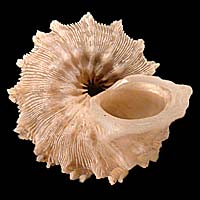|
< Previous family introduction |
|
|||||
 |
Family Turbinidae Turban shells, star shells, pheasant shells, and liotias
|
|||||
|
The Turbinidae is a large family of worldwide distribution, found at all latitudes and depths, but most diverse in tropical and subtropical shallow water environments. There are eighteen species occurring in NSW, including three species of large Turbo shells which are conspicuous on exposed rocky shores. The higher classification of the family has been revised by Hickman & McLean (1990), who divided it into nine subfamilies. Of these, only four - Liotiinae, Phasianellinae, Tricoliinae and Turbininae - occur in NSW. Subfamily Liotiinae These are small, low, wide, heavily sculptured shells commonly known as Wheel Shells or Liotias. They live from the intertidal down to several hundred meters. The group has variously been referred to Cyclostrematidae and to Liotiidae, but Hickman & McLean (1990) treat it as a subfamily of the Turbinidae. Laseron (1954) presented a revision of the group, with a wider concept of the family than is now recognized. Working only from empty shells, Laseron included many species which are now regarded as belonging to closely related families, particularly the Skeneidae, but also some in distantly related groups. It was not until Hickman & McLean's revision of the superfamily Trochoidea that the classification was put on a sound anatomical basis. There are six species of the Liotiinae recorded from NSW. One of these, Liotina peronii, is a tropical Indo-West Pacific species that is rarely found in northern NSW. The other five species belong to a southern Australian group of about 10 species. A few of them just reach into southern NSW, being more common in Victoria and Tasmania. Only one species, Austroliotia botanica, is at all common in NSW; it is found as a beach shell and occasionally living intertidally on rocky shores. The other species are uncommon, mainly occurring subtidally. Subfamily Phasianellinae Members of the Phasianellinae are known as Pheasant Shells because of their bright, multicoloured shells. According to Wilson (1993) there are only four species in Australia, three of which are endemic to this country; the two largest species are restricted to southern and eastern Australia. In southern Australia they live intertidally and in the shallow subtidal, and are common on seagrasses, where they graze on the epiphytic flora rather than the seagrass itself. One of the southern Australian species reaches into NSW, where is lives subtidally and attains a smaller size then in more southern cooler waters. Subfamily Tricoliinae These are small to minute shells with vibrant but variable colour patterns, and a calcareous operculum. The subfamily is of world wide distribution, mainly tropical and subtropical, but there are several species in southern Australia. They live intertidally and in the shallow subtidal, usually on algae or seagrasses, where they apparently feed on detritus and small epiphytic algae. They are among the most common small molluscs on algae in NSW, being abundant in some situations. The group is of note because of the sexual dimorphism found in some species; shell shape, shell size, radular characters, and perhaps diet differ between males and females. There are two species recorded from NSW; Tricolia rosea has a southern Australian distribution, and in NSW occurs only in the southern half of the state, where it is uncommon. Trocolia variabilis is a common tropical Indo-West Pacific species that reaches as far south as southern NSW. Another Indo-West Pacific species, T. fordiana, also occurs in Queensland but is not known from NSW. Two further species, T. tomlini and T. gabensis, occur in south-western WA. Subfamily Turbininae This subfamily is the most diverse within the Turbinidae, containing the star shells of the genera Astralium and Bolma, as well as the large, rocky shore shells of the genus Turbo. Many members of this group live in the shallow waters of tropical coral reefs, with numerous species occurring in northern Australia, and eight species occur in NSW. Two species of Astralium occur here, one of which is a common intertidal herbivore. The star shells of the genus Bolma only reach into the north of the state at the tail end of northern distributions; are all subtidal and uncommon. In contrast, species of Turbo are among the most conspicuous large molluscs on NSW exposed rocky shores, where they live among and consume algae, sheltering in crevices and under rocks. They were used for food by Aborigines, and are still harvested commercially for food on a small scale. Family References Liotiinae
Phasianellinae
Tricoliinae
Turbininae
Coverage All species of Turbinidae that occur in NSW are detailed here. Identification Notes Liotiinae shells are heavily sculptured with spiral and axial ribs and fine axial lamellae. They have an open umbilicus, circular aperture with a thick varix, and are slightly iridescent internally. They have a characteristic operculum that is corneous with rings of calcareous nodules. Phasianellinae shells are large and smooth with bright patterns, a closed umbilicus, thin outer lip without a varix and a calcareous operculum. Tricoliinae shells are similar to those of Phasianellinae but are small or minute, less than 5 mm in size in NSW. They have smooth rounded shells with a simple outer lip, without a varix. The umbilicus is only a chink. They have a calcareous operculum. They are distinguished from juvenile shells of the Phasianellinae by the umbilical chink, and by not having thin, brown, dashed spiral lines in the colour pattern. Turbininae shells encompass a variety of shapes, are medium to large in size (over 25 mm) and have a calcareous operculum. The only other large gastropods with a calcareous operculum are Phasianella, Neritidae and some species of Naticidae.
|